Photographing a Rocket Launch With a Swarovski Optik Scope
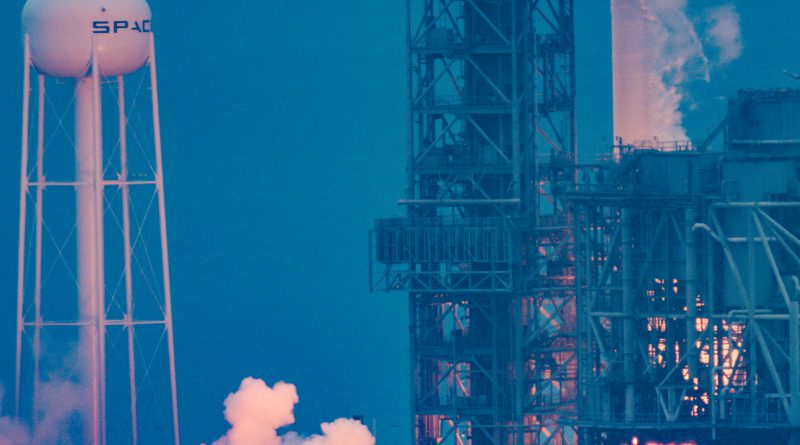
As a rocket photographer, my quest is "more zoom". Since we have to be miles away from the rocket at launch, the quest for longer glass seems endless. This past weekend, I had a chance to test a lens that provides amazing zoom capability in the form of a Scope from Swarovski Optik.
I remember arriving on the Space Coast of Florida in July 2011 for the final launch of the Space Shuttle. I had a seat on the Banana River some 12 miles away from the rocket. My 70-210 mm lens was tiny compared to the other folks lined up to watch the launch. Looking back at those photos, I can barely even make out the rocket sitting on the pad.
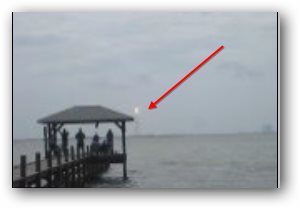
Today, I cover Cape Canaveral launches for We Report Space. That 70-210 mm lens has been replaced by a Canon 100-400mm lens. Our press credentials get our team to a spot about 4-6 miles away from the rocket (depending on the launch pad and the prevailing winds on launch day). Here is a shot of a Falcon 9 rocket launching 4.5 miles away from our position on the ITL Causeway. The photograph was shot with a Canon 7D and the Canon 100-400mm lens zoomed all the way out to 400mm. (Photo geeks will remind you that the 1.6 crop sensor on the 7D is making this equivalent to a 640 mm lens on a full-frame camera.) You can see the rocket, the lightning towers, the hangar and the rocket exhaust. This crops down to a nice 5x7 photo that hangs on my wall.
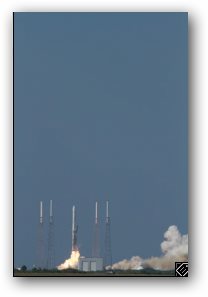
But to really see the power and the fury of the rocket engines, you generally have to place a remote camera at the pad a day before the launch. These cameras use Vela sound-activated triggers and are placed in plastic or metal boxes to keep the camera safe from being left out in the elements for one or two days. Since there is a good chance you will lose a lens to rocket exhaust or flying debris, we are generally risking kit lenses and used cameras for these photos.
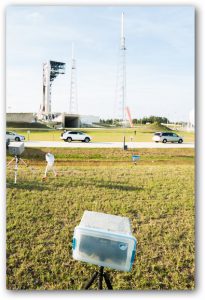
From these shots, you can see the ice crystals shaking off the rocket first stage. (The Liquid Oxygen fuel is so cold that Florida humidity condenses and then freezes on the rocket.) The violent shaking of the rocket lifting off causes the ice crystals to fall, creating my favorite fire & ice combination.
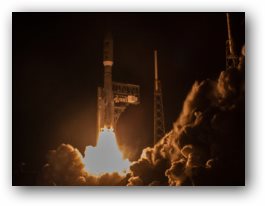
The Mysterious World of Digiscoping
While my passion is photographing rockets, my wife prefers to photograph birds. So, we found ourselves at the Space Coast Birding Festival for each of the last three years. People who attend birding festivals tend to range from people who want to see a bird and check it off their life list, to people who like to photograph birds. There is an expo of vendors who offer guided birding trips to remote locations, birding field guides, and camera gear. And then, there is the mysterious section in the expo hall with spotting scopes that are used for something called digiscoping. These look like miniature telescopes on a tripod. I was completely intimidated in year 1. In year 2, I could not figure out what specs these people were talking about. The “95mm at 30X to 70X” meant nothing to me. But in year 3, I met Clay Taylor.
Clay is the Naturalist Markets Manager for Swarovski Optik North America. I told to Clay that I was a guy shooting rocket launches with a Canon 7D and a 400 mm lens. I asked Clay to translate the scope specs into something I could understand.
Clay pulled up an image on his computer. It was a shot of the Space Shuttle launching and filled the frame. Clay took the picture from US 1 in Titusville – nearly the same spot where I had tried to photograph my first launch back in 2011. His image filled the frame.
Clay had me bring my 7D and 100-400 mm lens and we went outside. We took a photo with my camera at 400mm – it was a photograph of a red car parked across a field in a parking lot. Clay moved my Canon 7D body to the Swarovski scope. Same camera body. Same car. But now, it was a photo of the parking light of the car. I was intrigued.
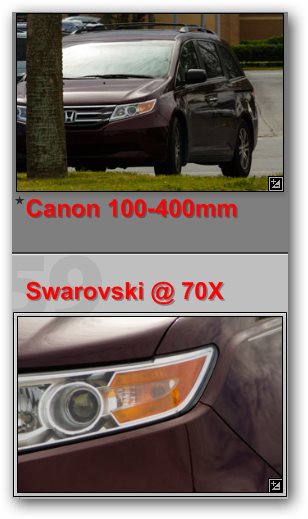
Let me translate from digiscoping specs to photography specs. The Swarovski 95mm scope offers from 30X to 70X magnification. At 30X, you are at the equivalent of a 900mm lens on the Canon 7D with an aperture of f/9.6. At 70X, you are at an astounding 2011mm with an aperture of f/22. I wanted to try out the scope for an upcoming rocket launch and Swarovski generously loaned me one for the launch of the SpaceX CRS-10 launch.
Rocket Photographs From the VAB
At NASA, you can only go to the roof of the iconic Vehicle Assembly Building (VAB) for certain launches. The building was built to stack the Saturn V rocket that carried three astronauts to the moon. It is 50 stories (523 feet) tall.
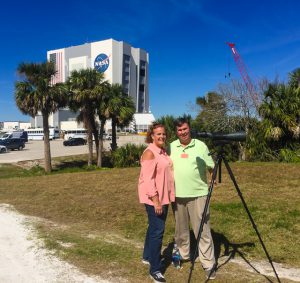
Each news organization can only send one representative to the roof and there is a limit of 30 people on the roof (in case of a rocket anomaly, NASA has to get everyone to safety and the elevator to the roof is limited.) So, it is hard to get up there. I’ve been there for two launches in three years. Here are the stats: I was 3.17 miles from the base of the rocket and 523 feet up. I set up the tripod at the rail of the VAB roof.
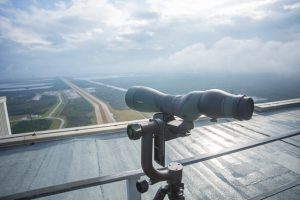
At this distance, the 30X zoom (equivalent to 900mm) was perfect. In fact, it was almost too much zoom. I had to frame the rocket in a vertical orientation. My dream shot would’ve had the iconic water tower on the left and the strong back erector on the right. New for this launch, the strong back erector retracts about 40 degrees so it left my frame. (This photo is the entire photo. It is not cropped.)
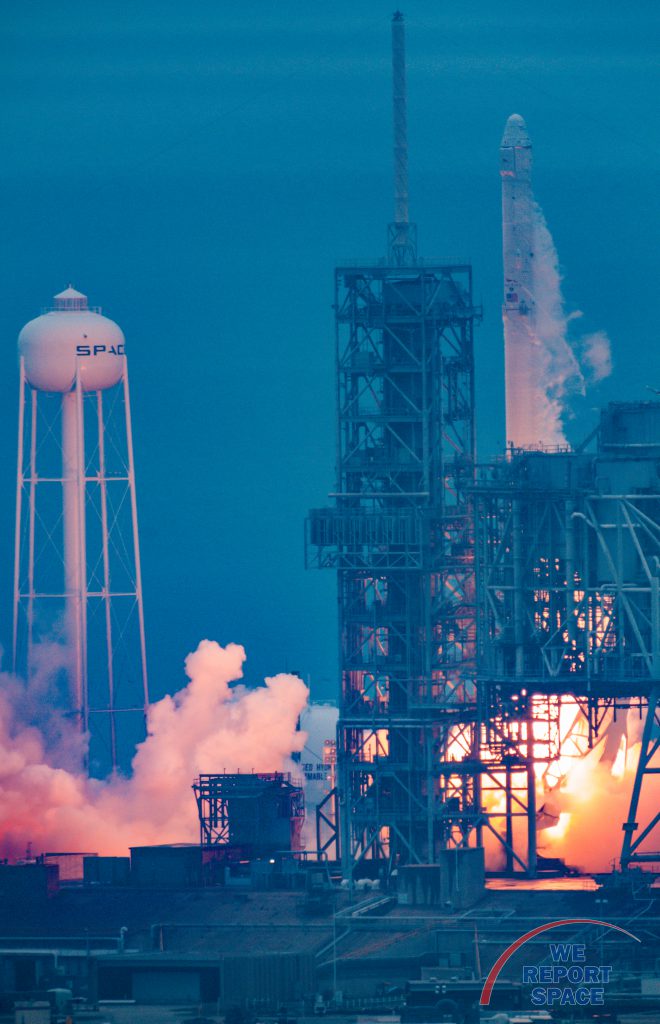
There is enough detail in that photo that our senior photo editor Jared Haworth used a cropped version in the launch article. Look close to see the ice crystals falling to the right of the flame. Ice crystals. From 3.17 miles away.
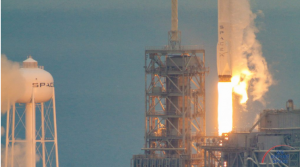
And remember, I was using the minimum zoom. Here is a shot from the prior day when the launch was scrubbed at T-13 seconds. This is 30X.
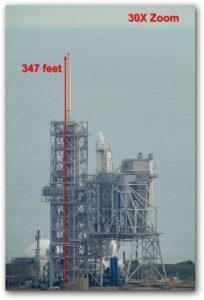
Compare this to full 70X zoom:
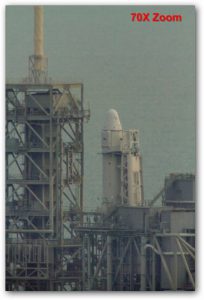
For comparison, a Canon 5D with a 200mm lens that was next to the Swarovski Scope. This is a great scene with the reflection in the foreground, but you are back to having the rocket appear fairly small in the frame:
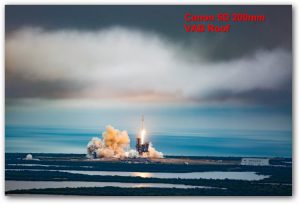
My editor Jared hoped that I would be able to track the rocket down range to get the brilliant red flame as the first stage burns out. This would have been awesome on the clear Saturday launch attempt. But that launch was scrubbed 13 seconds before ignition because a faulty steering valve. Sunday’s launch had heavy cloud cover making this downrange shot impossible.
Bird Photographs
In case your family has people interested in both rockets and birds, here are some bird comparisons. In this scene, I used my Canon 7D and the 100-400mm zoomed all the way to 400mm.
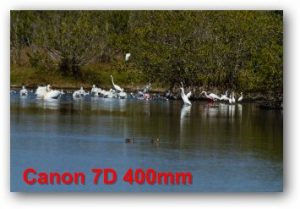
Here is the exact same scene, same camera, same spot, but with the Swarovski lens:
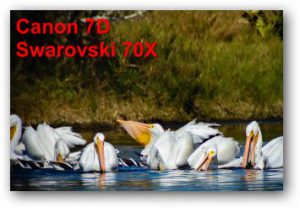
Photographer Caveats
- Swarovski offers a scope-to-camera adapter that works with the APS-sized digital camera sensors. That means you are fine if you are shooting with the 1.5x crop factor sensors for Nikon, Pentax, FuijFilm, and Sony as well as the 1.6x Canon sensors. But, if you have a full-frame camera such as the Canon 5D, you will have hard vignette in the corners. But, on the plus side, I was surprised that the scope filled my frame in either landscape or portrait orientations.
- You have to plan on shooting on a tripod. My loaner Swarovski rig included a mounting rail, but I went to the extra step of renting an Induro Gimbal head for my tripod to give me smooth panning ability. Even with that, pressing the shutter button would introduce a little shake, so I was sure to shoot with a remote cable. I am glad that I practiced on the day before the launch to get the hang of setting up the lens & camera so it was properly balanced on the gimbal head.
- Manual Zoom and Manual Focus: There are two large adjustment wheels that let you zoom from 30X to 70X and then adjust the focus. There are no autofocus electronics on the lens, so nothing in your camera is going to light up when you are in focus. Look through the lens or use LiveView to make sure your image is sharp.
- Light: this is a tiny aperture. Well – the f/9 for 900 mm isn’t bad. But the f/22 for 2011mm is small. I had the camera in Shutter Priority (Tv) mode for a 1/1000th shutter speed. I set the ISO to auto so the camera could achieve that shutter speed. In bright sunlight, I get great exposure at all zoom levels. But while shooting birds that were coming in to roost just before sunset, the light was fading fast and the ISO was pushed into levels that are too noisy on the original Canon 7D. I am shooting with an old Canon 7D Mark I where the noise at ISO about 1600 gets pretty bad. I can see I would be looking for a 7D Mark II in order to be able to push the ISO to 3200 or 6400.
- Focal Length is not the whole story with a lens. When you buy a Canon lens, you are getting autofocus, image stabilization, and a larger aperture.
- Lack of focal length and aperture reporting in Lightroom. To plan our exposures for upcoming launches, we frequently find previous launches in Adobe Lightroom to study the exposures used on previous launches. All the photos shot with the Swarovski lens will report a 50mm focal length with no aperture information.
Getting the Terms Right
If you are ready to purchase one of these rigs, you actually need 5 components. This was another point of confusion for me, so let me explain it for you. (The links below are to Amazon or Swarovski based on the lower price today.)
- The objective is the front piece of the lens. It comes in three sizes. I was testing with the 30-70x95. That is a 95mm front glass with 30x-70x zoom. There are two smaller sizes: 25-60x85 and 25-60x65. The specs on the 25-60x85 go from an effective zoom of 750mm at f/8.5 out to 1800mm at f/22. While the x95 resolves more detail, I would probably appreciate the flexibility of less zoom offered by the x85.
- The objective also needs an eye piece. There are only two choices here: STX is straight and ATX is angled up. I was using the STX on a tall tripod and it worked great. The price for either is the same.
- The two items above are for just looking at something far away. To take photos with a DSLR, you need an APO. This is short for Apochromat Telephoto Lens System. You take the final glass out of the eyepiece and replace it with this device. Note that as I unboxed the loaner lens, this is the one assembly step that was not obvious. This video from Swarovski helped me figure it out.
- Add a T2 converter and you are ready to attach it to your camera. There are converters for Nikon, Canon, Sony, and Micro 4/3.
- Finally, add a Mounting Rail for a stable connection to your tripod.
Pricing
Photography can be an expensive field. A new Canon 100-400 mm f/5.6 lens would be $2199. I know that moving up from that lens, Canon makes dramatically more expensive equipment. Their 800 mm lens is $12,999. The list price of all five components from Swarovski ranges from $4,630 for the 65mm to $5397 for the 85mm to $5775 for the 95mm. By shopping at Amazon using the links above, you can build the 85mm for $4981 and the 95mm for $5320. (The 65mm is less from Swarovski than Amazon at the moment so the best price is $4284 if you buy the objective from Swarovski and other items from Amazon). Note that Amazon prices change every hour, but these should be in the ballpark. Note that focal length is not the only important factor in a lens. You are paying Canon for autofocus, image stabilization and a larger aperture. But if your goal is to get focal distance in daylight and you can live with a fixed aperture and manual focus, the Swarovski system delivers high quality images.
Some Technical Details on The APO Camera Interface
Remember that the APO is the interface between the scope and your camera. In basic, the TLS APO 30 is a 30mm “pancake” style lens that was optically designed to do ONE thing – take the image created by a Swarovski Optik spotting scope and deliver it to a flat camera sensor. It’s f/stop is somewhere around f/8, but there is no diaphragm to change apertures because at that point in the optical path an adjustable aperture does not change the image quality nor affect depth of field. It is permanently focused at about 15 feet away, so “grab-shots” of people are possible with it, but it was never intended to do anything else other than shoot through the scope.
The TLS APO 30 has been optimized for the APS-sized digital camera sensors. There is a second TLS APO – this one a 23mm lens. The TLS APO 23 was designed for the Micro 4/3 sensors of Olympus and Panasonic and also the few cameras on the market with the “1-inch” sensor size. It gives LESS magnification than the APO 30. The Micro 4/3 shooters were concerned because combining 30mm APO with the 2x crop-factor of their sensor was giving them TOO MUCH magnification for larger subjects like herons and game animals. They were having to back up in order to get space for framing and composition, and their ultimate sharpness was getting compromised by heat shimmer and other atmospheric effects. There will be a TLS APO 43 released in June 2017 that is for the FX-sensor cameras.

Stunning, full color photo book covering every east coast launch spanning 2014-2015, including the first-ever powered landing of a SpaceX Falcon 9 rocket.
More Info



